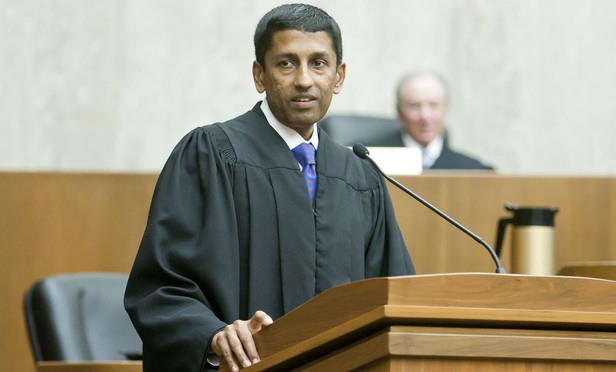A few law schools shelled out big bucks for judges to teach. Active federal judges couldn’t earn more than $26,955 in 2013 for teaching and other approved educational activities, but there is no such cap for senior judges.
Six senior judges reported teaching income of at least $100,000. Judge Douglas Ginsburg of the D.C Circuit earned the most, reporting $173,604 from George Mason University School of Law and $163,270 from New York University School of Law.
Ginsburg taught three classes at NYU in 2013, according to the law school. “In addition to enriching our curriculum, judges who teach here engage with students and contribute to the intellectual life of the law school in a way that is enormously valuable,” a law school spokesman said in an email to the NLJ.
At George Mason, Ginsburg taught three courses and helped establish the Global Antitrust Institute within the school’s Law and Economics Center, according to law school professor and former dean Daniel Polsby. “We kept him quite busy. And he’s gotten busier since,” Polsby said. “We’re quite delighted with the arrangement.”
Ginsburg did not return a request for comment.
Third Circuit Judge Anthony Scirica joined the senior judge top earners group in 2013. Scirica took senior status in July 2013. Over the second half of the year he reported earning $75,000 for teaching at the University of Pennsylvania Law School. He’s taught at Penn since 1997.
“I love teaching. It’s exciting, the students are terrific and the faculty at Penn has been welcoming,” Scirica said. When he took senior status in 2013, “I was 72 at the time and I thought, I’d like to teach more and I’m in a position where I can do that.”
Scirica said he hasn’t reduced his workload on the bench much since becoming a senior judge. “My friends tell me I’m going in the wrong direction in terms of workload, but it’s what I like,” he said.

Popular Publications
 Federal appeals judges reported more than $250,000 in royalties for books and other legal publications. Those payments ranged from a couple hundred dollars to tens of thousands of dollars. Judge A. Wallace Tashima (left) of the Ninth Circuit seemed to have the most popular publication, reporting $96,043 in royalty income from Thomson Reuters in 2013.
Federal appeals judges reported more than $250,000 in royalties for books and other legal publications. Those payments ranged from a couple hundred dollars to tens of thousands of dollars. Judge A. Wallace Tashima (left) of the Ninth Circuit seemed to have the most popular publication, reporting $96,043 in royalty income from Thomson Reuters in 2013.
Those royalties were for the three-volume “Federal Civil Procedure Before Trial” practice guide. In an email to the NLJ, Tashima said he’d had the same royalty arrangement for 30 years with the practice guide’s publishers—The Rutter Group, which was acquired by West Publishing. Thomson Reuters later acquired West Publishing.
Judicial Threads

From a distance, judges’ robes can look identical—roomy folds of black cloth with puffy sleeves. But up close, they can vary in everything from material and shape to whether they include pockets (a hot topic among judges.) Pre-fab models can cost under $100, but custom, luxury fabric robes can cost much more. D.C. Circuit Judge Sri Srinivasan, confirmed by the U.S. Senate in 2013, sports a robe valued at $460, according to his financial report. It was a swearing-in gift from his former colleagues in the Office of the Solicitor General, where Srinivasan served before his appointment to the bench.
Srinivasan’s report didn’t include any details about where the robe was made. The judge and the Justice Department declined interview requests.
Extrajudicial Hobbies

Judges typically earned extra income off the bench by teaching law school courses, but a few judges reported unusual sources. Third Circuit Judge Jane Roth reported selling an original watercolor painting in 2013 for $350. Roth has an artistic background. She majored in art history in college—a field that she said prepared her for a career in the law, since it “teaches you…what’s important and what details need to be considered and what don’t.” She’s taken painting lessons for at least two decades.
In 2013, she said she was asked to contribute a painting for a benefit event for an art studio in Wilmington, Delaware. Her painting, of a tulip magnolia branch, sold.
“I think everybody needs a hobby to relax and I find painting very relaxing,” Roth said. “It clears my mind of all the legal things I’m thinking about.”
On-Call Judge

Tenth Circuit Judge Paul Kelly Jr. reported a $1,234 stipend in 2013 for his work with the Santa Fe County Fire Department. Kelly has been a volunteer firefighter for the county since 1989, according to the fire department. Kelly declined an interview request.
In 2013, Kelly responded to emergency calls approximately 60 times. The department’s 300-plus volunteers have pagers and can respond to calls when they’re available.
“We have folks from all over the community, people from all walks of life who do this,” Fire Chief David Sperling said.



